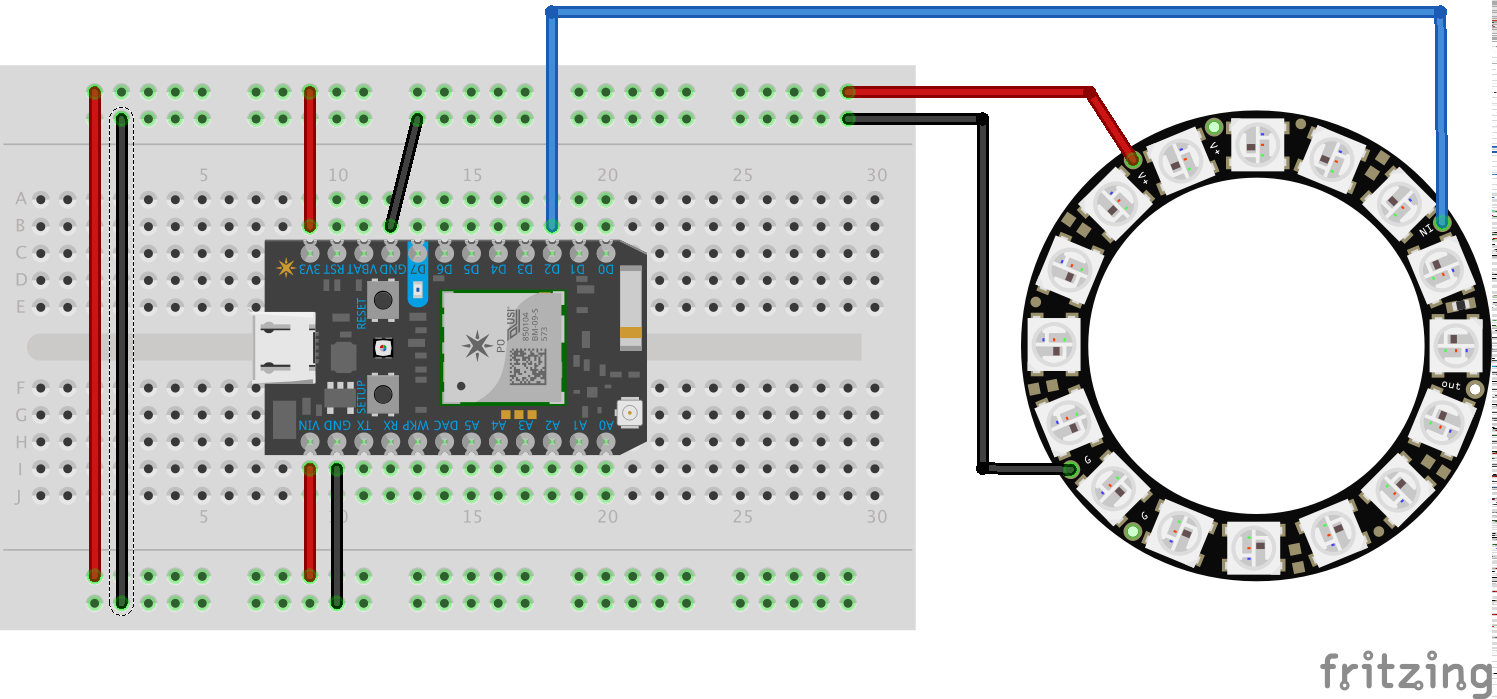Particle Light Alexa Save
Asking Amazon Alexa to control a light ft. NeoPixels and Particle Photon
particle-light-alexa
Ask Amazon Alexa to control a light. In this case, the "light" is a NeoPixel ring connected to a Particle Photon. The functions to control the light are exposed through the Particle Cloud. The Alexa skill then calls the functions using the JavaScript Particle API.
Note: You don't need an Amazon Alexa device to get started... although it's certainly more fun if you have an Echo, Tap, or Dot! You can use Echosim.io, which is a web-based Alexa skill testing tool.
Supplies
- Particle Photon
- NeoPixel Ring - 16 x 5050 RGBW LEDs
- Breadboard
- Jumper wires
Setting up Particle
Hardware configuration
Go through the Particle Photon Getting Started Guide to get your Photon up and running. Then, wire up the board.
Here's a picture of the circuit:

And, here's a schematic that makes the wiring a bit clearer:

To make it easier to wire up the NeoPixel ring, I used a second breadboard to connect V+, Data In, and GND.
Using the Particle Dev IDE
- Download the Particle Dev IDE and follow the instructions on how to log into your account and select your device.
- Open
ino/light.inoin the IDE. - Send the code to the board
- Select the Compile button. If it's compiled successfully, the status bar on the bottom should say, "Success!"
- Send the code to the board by selecting the Flash button. Again, if it's successful, the status bar should say, "Success!"
Setting up Amazon Alexa Services
Adding Particle credentials to Alexa skill
Update PARTICLE_DEVICE_ID and PARTICLE_ACCESS_TOKEN in particle-light-alexa/alexa/src/index.js. You can find your device ID at console.particle.io/devices and your access token under Settings in build.particle.io.
AWS Lambda Setup
- Navigate to
particle-light-alexa/alexa/src
- Type
npm installto install the required Node.js packages - Zip up all the files in the
srcfolder—includingnode_modules— but not thesrcfolder itself! - Go to your AWS Console and navigate to AWS Lambda
- Make sure the region is US East (N. Virginia)
- If you have no Lambda functions yet, click Get Started Now; otherwise, click Create a Lambda Function
- Skip the step Select blueprint
- In Configure triggers, select Alexa Skills Kit from the gray dotted box, then click Next
- In Configure function:
- Name: ParticleLight
- Runtime: Node.js 4.3
- Code entry type: Upload a .ZIP file
- Select the .ZIP file created in step 3
- Handler: index.Handler
- Role: Choose an existing role
- Existing role: lambda_basic_execution
- Memory (MB): 128
- Timeout: 0 min 10 sec
- I increased the default from 3 sec to 10 sec to give enough time for the request to process
- VPC: No VPC
- Then, create the function
- Make note of ARN for the new Lambda function, which is on the upper-right of the function page... you'll need this when setting up the Alexa skill
Alexa Skills Setup
- Go to your Amazon Developer Dashboard and select Alexa
- Select Get Started with Alexa Skills Kit
- Select Add a New Skill
- In Skill Information:
- Skill Type: Custom Interaction Model
- Name: ParticleLight
- Invocation Name: particle light
- Audio Player: No
- In Interaction Model:
- Intent Schema: Copy and paste the content from
particle-light-alexa/alexa/speechAssets/IntentSchema.json - Custom Slot Types: Select Add Slot Type
- Enter Type: LIST_OF_COLORS
- Enter Values: Copy and paste the content from
particle-light-alexa/alexa/speechAssets/LIST_OF_COLORS.txt
- Custom Slot Types: Select Add Slot Type
- Enter Type: LIST_OF_STATES
- Enter Values: Copy and paste the content from
particle-light-alexa/alexa/speechAssets/LIST_OF_STATES.txt
- Sample Utterances: Copy and paste the content from
particle-light-alexa/alexa/speechAssets/SampleUtterances.txt
- Intent Schema: Copy and paste the content from
- In Configuration:
- Endpoint: Lambda ARN
- Copy and paste the ARN from the last step of AWS Lambda Setup
- Account Linking: No
- Endpoint: Lambda ARN
Using Echosim.io
- Go to Echosim.io
- Try out either one of these commands:
- Alexa, open particle light
- Alexa, ask particle light to turn {on | off}
- Alexa, ask particle light to change color to {red | green | blue | white}
- Alexa, ask particle light to set brightness level to {x}, where x is 0-255
And, Alexa should respond accordingly! You can also try this out with your own Alexa-enabled device.
